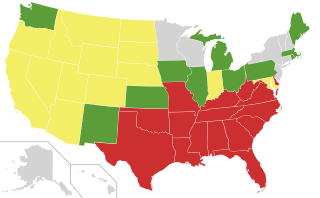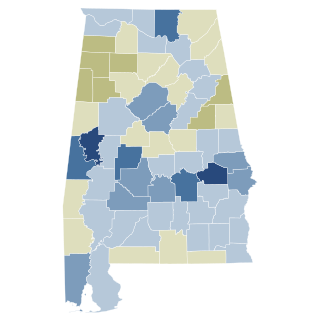
Racial segregation is the separation of people into racial or other ethnic groups in daily life. Segregation can involve the spatial separation of the races, and mandatory use of different institutions, such as schools and hospitals by people of different races. Specifically, it may be applied to activities such as eating in restaurants, drinking from water fountains, using public toilets, attending schools, going to films, riding buses, renting or purchasing homes or renting hotel rooms. In addition, segregation often allows close contact between members of different racial or ethnic groups in hierarchical situations, such as allowing a person of one race to work as a servant for a member of another race. Racial segregation has generally been outlawed worldwide.
Immorality Act was the title of two acts of the Parliament of South Africa which prohibited, amongst other things, sexual relations between white people and people of other races. The first Immorality Act, of 1927, prohibited sex between whites and blacks, until amended in 1950 to prohibit sex between whites and all non-whites. The second Immorality Act, of 1957, continued this prohibition and also dealt with many other sex offences. The ban on interracial sex was lifted in 1985, but certain sections of the 1957 act dealing with prostitution remain in force as the "Sexual Offences Act, 1957".
Loving v. Virginia, 388 U.S. 1 (1967), was a landmark civil rights decision of the U.S. Supreme Court which ruled that laws banning interracial marriage violate the Equal Protection and Due Process Clauses of the Fourteenth Amendment to the U.S. Constitution. Beginning in 2013, the decision was cited as precedent in U.S. federal court decisions ruling that restrictions on same-sex marriage in the United States were unconstitutional, including in the Supreme Court decision Obergefell v. Hodges (2015).
The one-drop rule was a legal principle of racial classification that was prominent in the 20th-century United States. It asserted that any person with even one ancestor of black ancestry is considered black. It is an example of hypodescent, the automatic assignment of children of a mixed union between different socioeconomic or ethnic groups to the group with the lower status, regardless of proportion of ancestry in different groups.

The Population Registration Act of 1950 required that each inhabitant of South Africa be classified and registered in accordance with their racial characteristics as part of the system of apartheid.

A ban is a formal or informal prohibition of something. Bans are formed for the prohibition of activities within a certain political territory. Some bans in commerce are referred to as embargoes. Ban is also used as a verb similar in meaning to "to prohibit".

In 1924, the Virginia General Assembly enacted the Racial Integrity Act. The act reinforced racial segregation by prohibiting interracial marriage and classifying as "white" a person "who has no trace whatsoever of any blood other than Caucasian". The act, an outgrowth of eugenicist and scientific racist propaganda, was pushed by Walter Plecker, a white supremacist and eugenicist who held the post of registrar of the Virginia Bureau of Vital Statistics.
McLaughlin v. Florida, 379 U.S. 184 (1964), was a case in which the United States Supreme Court ruled unanimously that a cohabitation law of Florida, part of the state's anti-miscegenation laws, was unconstitutional. The law prohibited habitual cohabitation by two unmarried people of opposite sex, if one was black and the other was white. The decision overturned Pace v. Alabama (1883), which had declared such statutes constitutional. It did not overturn the related Florida statute that prohibited interracial marriage between whites and blacks. Such laws were declared unconstitutional in 1967 in Loving v. Virginia.

The system of racial segregation and oppression in South Africa known as apartheid was implemented and enforced by many acts and other laws. This legislation served to institutionalize racial discrimination and the dominance by white people over people of other races. While the bulk of this legislation was enacted after the election of the National Party government in 1948, it was preceded by discriminatory legislation enacted under earlier British and Afrikaner governments. Apartheid is distinguished from segregation in other countries by the systematic way in which it was formalized in law.

Legislation seeking to direct relations between racial or ethnic groups in the United States has had several historical phases, developing from the European colonization of the Americas, the triangular slave trade, and the American Indian Wars. The 1776 Declaration of Independence included the statement that "all men are created equal", which has ultimately inspired actions and legislation against slavery and racial discrimination. Such actions have led to passage of the 13th, 14th, and 15th Amendments to the Constitution of the United States.
Pace v. Alabama, 106 U.S. 583 (1883), was a case in which the United States Supreme Court affirmed that Alabama's anti-miscegenation statute was constitutional. This ruling was rejected by the Supreme Court in 1964 in McLaughlin v. Florida and in 1967 in Loving v. Virginia. Pace v. Alabama is one of the oldest court cases in America pertaining to interracial sex.
Prostitution in South Africa is illegal for both buying and selling sex, as well as related activities such as brothel keeping and pimping. However, it remains widespread. Law enforcement is poor.

Interracial marriage has been legal throughout the United States since at least the 1967 U.S. Supreme Court decision Loving v. Virginia (1967) that held that anti-miscegenation laws were unconstitutional via the 14th Amendment adopted in 1868. Chief Justice Earl Warren wrote in the court opinion that "the freedom to marry, or not marry, a person of another race resides with the individual, and cannot be infringed by the State." Interracial marriages have been formally protected by federal statute through the Respect for Marriage Act since 2022.
Anti-miscegenation laws are laws that enforce racial segregation at the level of marriage and intimate relationships by criminalizing interracial marriage and sometimes, they also criminalize sex between members of different races.

In the United States, many U.S. states historically had anti-miscegenation laws which prohibited interracial marriage and, in some states, interracial sexual relations. Some of these laws predated the establishment of the United States, and some dated to the later 17th or early 18th century, a century or more after the complete racialization of slavery. Nine states never enacted anti-miscegenation laws, and 25 states had repealed their laws by 1967. In that year, the U.S. Supreme Court ruled in Loving v. Virginia that such laws are unconstitutional under the Fourteenth Amendment to the U.S. Constitution.

The Immorality Act, 1927 was an act of the Parliament of South Africa that prohibited extramarital sex between white people and people of other races. In its original form it only prohibited sex between a white person and a black person, but in 1950 it was amended to apply to sex between a white person and any non-white person.

The Sexual Offences Act, 1957 is an act of the Parliament of South Africa which, in its current form, prohibits prostitution, brothel-keeping and procuring, and other activities related to prostitution. Before the law relating to sex offences was consolidated and revised by the Criminal Law Amendment Act, 2007, it also prohibited various other sex offences, including sex with children under the age of consent and sex with the mentally incompetent. As the Immorality Act it was infamous for prohibiting sex between a white person and a person of another race, until that prohibition was removed by a 1985 amendment.

The Immorality and Prohibition of Mixed Marriages Amendment Act, 1985 is an act of the Parliament of South Africa that repealed the laws prohibiting marriage and sexual intercourse between white people and people of other races. It was one of the early legislative steps towards the end of apartheid.

2000 Alabama Amendment 2, also known as the Alabama Interracial Marriage Amendment, was a proposed amendment to the Constitution of Alabama to remove Alabama's ban on interracial marriage. Interracial marriage had already been legalized nationwide 33 years prior in 1967, following Loving v. Virginia, making the vote symbolic. The amendment was approved with 59.5% voting yes, a 19 percentage point margin, though 25 of Alabama's 67 counties voted against it. Alabama was the last state to officially repeal its anti-miscegenation laws, following South Carolina in 1998.









